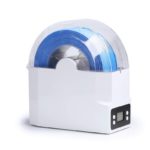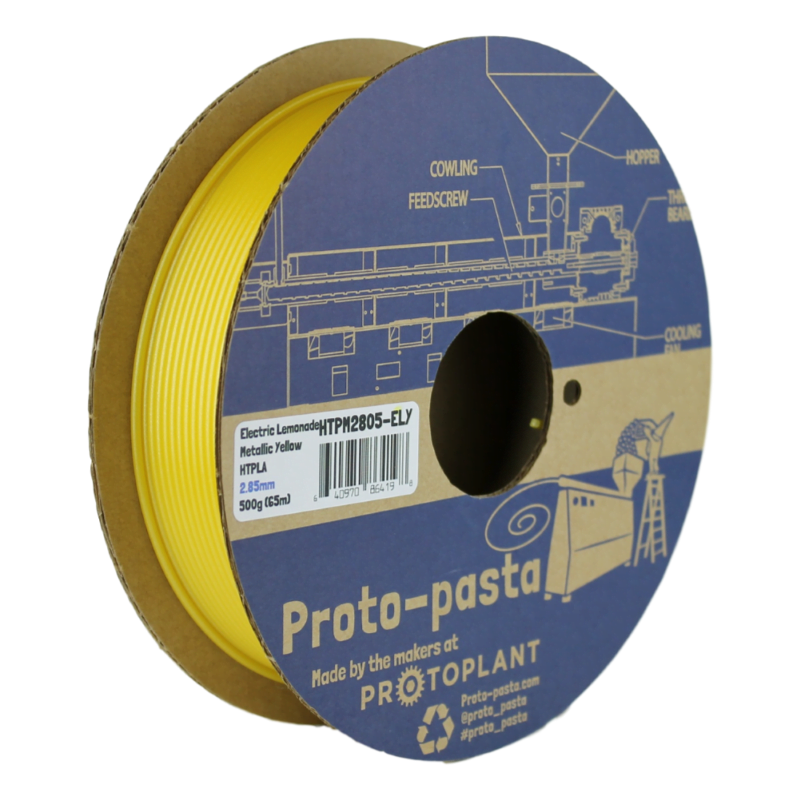
ProtoPasta é uma empresa situada nos Estados Unidos da América, de produção de filamentos para impressão 3D de alta qualidade.
Caracterizada pelos rolos feitos em cartão, esta marca é mundialmente famosa por ser especializada em materiais como PLA e ABS modificados com outros materiais, como o PLA Magnético; o PLA Condutivo; PLA de fibra de carbono; HTPLA de cobre, latão ou bronze; ou o ABS-PC.


“Electric Lemonade” is a custom color designed by Steve Abrams (@Artobot on Instagram & Twitter) in collaboration with Proto-pasta at our 2nd Filament Workshop.
Scroll to the bottom workshop page to enjoy the video and reviews.
Below, check out Steve’s workshop spools and a beautiful Electric Lemonade print.
For more of Steve’s work, you can also visit his etsy store.


Premium filament for world-class quality, finish & performance.
- Automotive-inspired metallic finish for layer-hiding texture without finishing.
- High performance HTPLA with stability up to 160C (320F) after heat-treating.
- Adaptable to most PLA-compatible 3D printers accepting 3rd party materials.
- Crafted in the USA with consideration for man, machine & the environment.
HEAT TREATING
Like our other HTPLAs, Metallic HTPLA can be “Heat Treated” to increase crystallinity for “Higher Temperature” resistance compared to amorphous PLA, ABS, and co-polyesters like PETG! Glittler Flake HTPLA prints translucence, but turns opaque when heat treated (or crystallized). With a more crystalline structure, heat treated HTPLA parts can hold form to near melting, though temperatures where the material is practically useful vary greatly depending on geometry and load conditions! For this improved the performance, your prints should be baked in an oven until you see a change from translucent to opaque with reduced gloss. This visual change indicating the improved performance! We’ve seen the change take place in 5-10 minutes on thin walled parts but can take an hour or more. We’ve had good luck in a quality, at home convection oven at 110C (225F). Parts will get very “floppy” before becoming more firm, so please leave supports on your parts or support them and bake them on a flat, non-radiating surface (like glass, ceramic, or composite).
For this improved performance, your prints should be baked in an oven until you see a change from translucent pink to opaque pink with reduced gloss. This visual change indicates the improved performance! We’ve seen the change take place in 5-10 minutes on thin walled parts but can take an hour or more. We’ve had good luck in a quality, at home convection oven at 110C (225F). Parts will get very “floppy” before becoming more firm, so please leave supports on your parts or support them and bake them on a flat, non-radiating surface (like glass, ceramic, or composite).
PRINTING
In our experience, good results were achieved using standard PLA parameters ranging from 195-225C nozzle with standard build surface preparation (blue tape, glue stick, or BuildTak). No heated bed required but up to 60C is okay. Beware, if the bed temperature is too high, your part base could actually heat treat while printing, increasing warping and decreasing adhesion. Some shrinkage will occur in the heat treating process, so dimension critical parts may need to be scaled appropriately (as much as 2.5% in our experience).
- No abrasive fillers so expect normal wear with standard nozzles.
- Available in 1.75 & 2.85 (3) mm diameter on a 50g diameter recyclable cardboard spool
- Usable on most PLA-compatible printers, such as Lulzbot, Makerbot, FlashForge, Dremel, Ultimaker, Printrbot, and more!
High Temperature PLA ( HTPLA )
Looking for increased heat resistance without the need to switch to ABS? Protopasta High Temperature PLA offers heat deflection of up to 88° C (190.4° F) compared to standard PLA of 45-54° C (113-135° F). This makes it a great choice for moving parts (gears, RepRap pieces, etc) or prints that would face moderately high temperatures. Our High Temperature PLA is white, but can be painted after annealing.
Protopasta High Temperature PLA is made from a mineral filled, impact modified PLA with a nucleating agent to help promote crystallization. Crystallization after printing is what gives this material added heat resistance, so post-print annealing is essential to activate the heat deflection qualities of this material.How do I anneal my print?
You can anneal your finished prints several ways, the two easiest ways are by using hot (but not boiling) water or by placing it in a low temperature oven (newer oven models only). Follow these steps:
- Water Method: Find a pot large enough to hold your print and fill it halfway with water. On medium heat, heat the water until it reaches 95-115 C (200-240 F) (a cooking thermometer works great for this), turn the heat to low and submerge the print in the warm water bath for 6-10 minutes. Placing a lid on your pot will help the water maintain temperature.
- Oven Method: Many newer ovens often have low temperature settings (sometimes called “keep warm” or “bread proof”). Set your oven to 95-115 C (200-240 F), place your finished print on a tray, and set it in the oven for 6-10 minutes.
- SUPPORT YOUR PRINT! Because the annealing process will soften the plastic somewhat, it’s best to support your print during this process.
Because 3D printers vary so much from model to model, and because many RepRap printers combine parts from several manufactures, we can’t provide the optimum temperature for your machine. Generally, our customers find it prints just like standard PLA on their machines (at around 210° C), though others find success running it a bit hotter (around 220° C).Do I need a heated bed? No, High Temp PLA does not require a heated bed or an enclosure.

Getting Started with Proto-pasta PLAs including HTPLA
We’ve created this page to bring you a premium PLA and HTPLA printing experience that rivals our premium material. Follow below to improve your 3D printing experience. In other words, here’s your shortcut to awesomeness with pasta. If at the end of this document you have questions or need assistance, please contact us at [email protected].
Filament Handling
Loose coils can be very tricky to manage. Going cowboy on your spool handling can quickly end up in a frustrating, tangled mess. Keep your loose coils wrangled with a spool holder like masterspool for a more trouble-free experience. Find out more about loose coil handling in Keith’s blog post.
And for spooled filament, never let go of the loose end. When not in the printer extruder, tuck it away in the cardboard spool’s corrugation! Also, avoid sharp bends and excessive force when loading filament into your printer.
Print settings
At Proto-pasta, we make high quality filament. We aspire to make exceptional results easy, but a positive result is very much dependent on your hardware, set-up, adjustments, and process parameters. Matching hardware with process and material for a positive experience is not always straight-forward, but you can start by pairing the following settings with your printer for a good starting point, then tune or troubleshoot as required.
Example settings for typical printer
- Nozzle size = 0.4 mm (Standard to most printers & balances detail with productivity.)
- Extrusion width = 0.45 mm (Typically larger than nozzle size. If using a larger nozzle diameter, be sure to set the extrusion width larger than that nozzle diameter.)
- Layer thickness = 0.15 mm (For a balance of speed, quality & reliability.)
- Speed(s) = 15-45 mm/s (Respecting mechanical and volume flow limits. Stay within the recommended speed range but apply slower speeds to the walls and faster speeds to the infill.)
- Volume flow rate(s) = 1-3 cu mm/s (The result of above speed range, width, and layer thickness. Respect hardware and geometry limitations.)
- Typical temperature = 215 C +/- 10 C (Matching material, hardware, and volume flow rate.)
Volume flow rate together with temperature dictates how melted the material is. This is hardware & condition dependent based on hot end, nozzle & extruder type, material & manufacturer as well as layer fan type, position & settings. Extrusion width, layer thickness & speed changes affect volume flow which may change required/desired temperature.
Additional settings of note
- “Grid” infill type at 20-30% – “connect infill lines” unchecked (off).
- Minimum 3 shells & 4 top/bottom layers for good surface quality.
- Layer fan set to cool enough for build rate, but not so aggressive as to fail process by over-cooling nozzle and heater block.
Validation and fine-tuning
- Single wall box to tune temperature and extrusion-related settings.
- Protognome to validate results.
Post your prints & tag us @Proto_pasta on Twitter and Instagram. Need more help? Consider typical pitfalls and fixes below.
Typical pitfalls
- Exceeding hardware capabilities.
- Mismatch of flow rate and temperature.
- Excessive nozzle cooling from layer fan yielding lower heater block and/or nozzle temperatures than set point.
- Hardware shortcomings such as MK3 heat break, poor nozzle diameter, or other hangups.
- Poor assembly or adjustment of components.
- Excessive retraction distance or number of retractions.
- Inaccurate flow with missing cross-sections or wall thickness not matching extrusion width software setting.
Typical Fixes
- Heat break replacement with OEM, straight-through design and defect-free, smooth bore.
- Proper assembly of components without plastic oozing gaps & with thermal grease.
- Lightly oiling filament, but careful, a little goes a long way.
- Reducing layer fan speed and/or isolating from heater block and nozzle.
- Installing heater block sock to isolate heater block & nozzle from layer fan.
- Increasing temperature to flow past internal hang-ups.
- Reduce speed and/or choose a single speed for a single volume flow
- Consider drive gear tension adjustment, bowden tube coupling/replacement, and spool mounting
We visited Joel and ended up with a helpful video on the subject:

Para uma correcta manutenção da sua impressora 3D, recomendamos sempre que trocar de material de filamento 3D, a efectuar uma purga com filamento especial de limpeza.
Desta forma garante que não ficam vestígios de material nas paredes do nozzle, evitando o acumular de crosta que é criado sempre que efectua trocas de material.
Com este produto evita problema como “clogs” e “jams” e fará com que o seu nozzle mantenha-se sempre limpo, durando muito mais tempo.
Poderá encontrar a partir de 1.49€ no seguinte LINK

Para obter maior aderência à superfície da sua impressora 3D recomendamos a aplicar 3DLAC na base da plataforma.
Poderá encontrar no seguinte LINK

Este material é altamente higroscópico, absorvendo rapidamente a humidade do ar passados poucos minutos após aberto, impossibilitando desta forma a correcta impressão 3D do mesmo. O resultado das impressões 3D de materiais com humidade tendem a ser frágeis e de acabamento irregular ou em certos casos, torna-se simplesmente impossíveis de imprimir.
Deverá de usar soluções de caixas fechadas com dessecante como sílica ou caixas próprias secadoras de filamento.
Poderá encontrar no seguinte LINK
Download:
Technical and Safety Data Sheet
50g– Rolo
HTPLA Artobot “Electric Lemonade” Metallic Yellow HTPLA ( Community Inspired ) – Cor
1.75mm (+-0.05mm) – Espessura / Tolerância de diâmetro
Muito Fácil – Facilidade de Impressão


